A new University of British Columbia Okanagan study indicates an Indigenous-led conservation effort for mountain caribou is showing promise.
Caribou numbers across the country are declining, in large part due to human activity.
But one herd of mountain caribou in central B.C. known as the Klinse-Za, has seen its numbers going in the opposite direction, thanks to a collaborative recovery effort led by West Moberly First Nations and Saulteau First Nations. The herd is located between Mackenzie, Chetwynd and the Peace Arm of Williston reservoir.
The Indigenous-led conservation initiative paired short-term recovery actions such as predator reduction and caribou guardians at maternal pens, with ongoing work to secure landscape-level protection in an effort to create a self-sustaining caribou population.
Dr. Clayton Lamb, a Liber Ero Fellow, along with Carmen Richter, a biology master’s student, and Dr. Adam T. Ford, Canada research chair in wildlife restoration ecology, conduct research in the Irving K. Barber Faculty of Science. Their latest study shows Klinse-Za caribou numbers have nearly tripled in under a decade.
“We have an Indigenous-led conservation effort to thank for averting the looming extinction of this herd,” says Dr. Lamb. “The population was declining rapidly—a West Moberly Elder once described the herd as a ‘sea of caribou,’ but by 2013 it had declined to only 38 animals.”
Today, the herd count is more than 110 and numbers continue to rise.
“This work provides an innovative, community-led, paradigm shift to conservation in Canada,” Dr. Lamb says. “While Indigenous Peoples have been actively stewarding landscapes for a long time, this approach is new in the level of collaboration among western scientists and Indigenous Peoples to create positive outcomes on the land and put an endangered species on the path to recovery.”
Richter, who is a Saulteau First Nations member, says Indigenous communities have really come together for the good of the caribou.
“This is truly an unprecedented success and signals the critical role that Indigenous Peoples can play in conservation,” says Dr. Ford. “I hope this success opens doors to collaborative stewardship among other communities and agencies. We can accomplish so much more when working together.”



